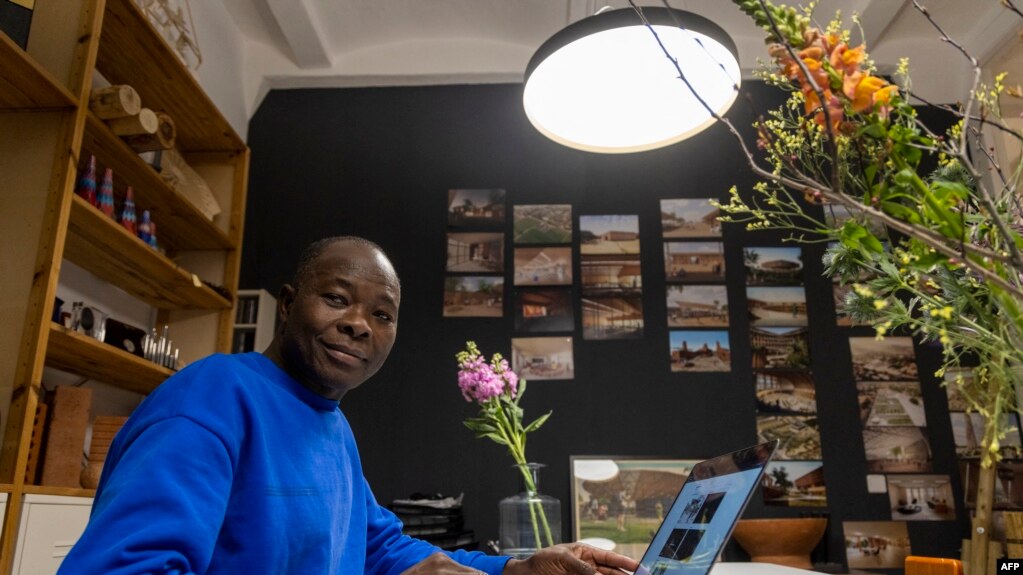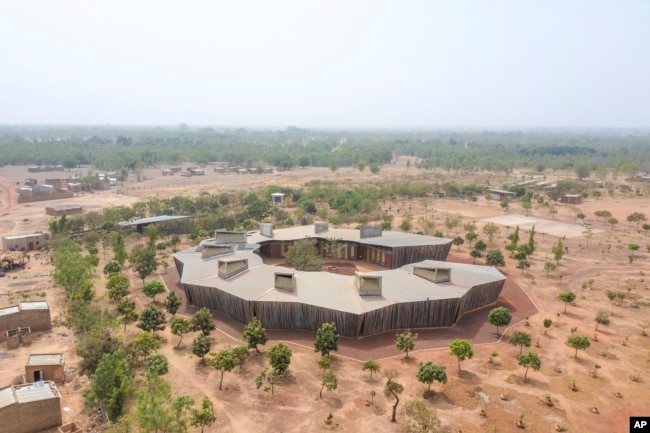
Burkinabe architect Diebedo Francis Kere is photographed in his office in Berlin, on March 15, 2022, after being awarded the 2022 Pritzker Architecture Prize.
Architect Diébédo Francis Kéré of Burkina Faso has won the Pritzker Prize, the world’s highest recognition in building design.
The 56-year-old Kéré was honored Tuesday for his “pioneering” designs, said Tom Pritzker, He is chairman of the Hyatt Foundation, which awards the prize. The architect’s works, he continued, are “sustainable to the earth and its inhabitants — in lands of extreme scarcity.”
Kéré is a citizen of both Burkina Faso and Germany and lives in Berlin. On Tuesday, he said he was the “happiest man on this planet” to become the 51st recipient of the famous yearly prize.
Kéré is famed for building schools, health centers, housing, and other and public spaces across Africa. His buildings can be found in his homeland, as well as in Benin, Mali, Kenya, Mozambique, Togo and Sudan.
“He is equally architect and servant, improving upon the lives and experiences of countless citizens in a region of the world that is at times forgotten,” Pritzker said.

This image released by the Pritzker Prize shows the Lycée Schorge in Burkina Faso. The Pritzker Architecture Prize has been awarded to its designer, Berlin-based architect Diébédo Francis Kéré. (Francis Kéré via AP)
Kéré won special praise for his 2001 project to build a primary school in Gando, the village where he was born.
Unlike traditional school buildings, which use concrete, Kere’s inventive design combined local clay and cement to form bricks. The material helps keep the building cool in a hot environment.
A wide, raised metal roof protects the building from rain and helps air flow.
Kéré involved the local community throughout the design and building of the school. The number of students at the school increased from 120 to 700, the Hyatt Foundation said in its release.
The success of the project saw the creation of an extension, a library and teachers’ housing in later years.
Kéré “empowers” communities through the process of architecture, the Pritzker statement added. It praised Kere additionally for loyalty to social justice and community empowerment.
Kéré is the first African to be honored with the Pritzker. In his native Burkina Faso, citizens celebrated the win.
“In the current pain of the security crisis, our country must remember that it is also the nation of exceptional men like Francis Kéré ,” said Ra-Sablga Seydou Ouedraogo, of the non-profit Free Afrik.
Nebila Aristide Bazie, head of the Burkina Faso architects’ council, said the award “highlights the African architect and the people of Burkina Faso.”
In 2017, Kéré designed the Serpentine Pavilion in London’s Hyde Park. The highly sought contract is given to a world-famous architect every year. He was also one of the architects behind Geneva’s International Museum of the Red Cross and Red Crescent.
“I am totally convinced that everyone deserves quality,” he said in his office, where he celebrated his award with his team. “I’m always thinking how I can get the best for my clients,” Kéré added, noting that his clients include people who can pay and those who cannot.
He said, “This is my way of doing things, of using my architecture to create structures to serve people, let’s say to serve humanity.”
I’m Caty Weaver.
Caty Weaver adapted this story from an Agence France-Press wire report.
___________________________________________________________________
Words in This Story
architect –n. a person who designs buildings
sustainable –adj. involving methods that do not completely use up or destroy natural resources
region –n. a part of a country, of the world, etc., that is different or separate from other parts in some way
client –n. a person who employs a professional person or organization for services
library –n. a place where books, magazines, and other materials (such as videos and musical recordings) are available for people to use or borrow
concrete –n. a hard, strong material that is used for building and made by mixing cement, sand, and broken rocks with water
clay –n. a heavy, sticky material from the earth that is made into different shapes and that becomes hard when it is baked or dried
cement –n. a soft gray powder that is mixed with water and other substances to make concrete
inhabitant –n. a person or animal that lives in a particular place
scarcity –n. a very small supply of something